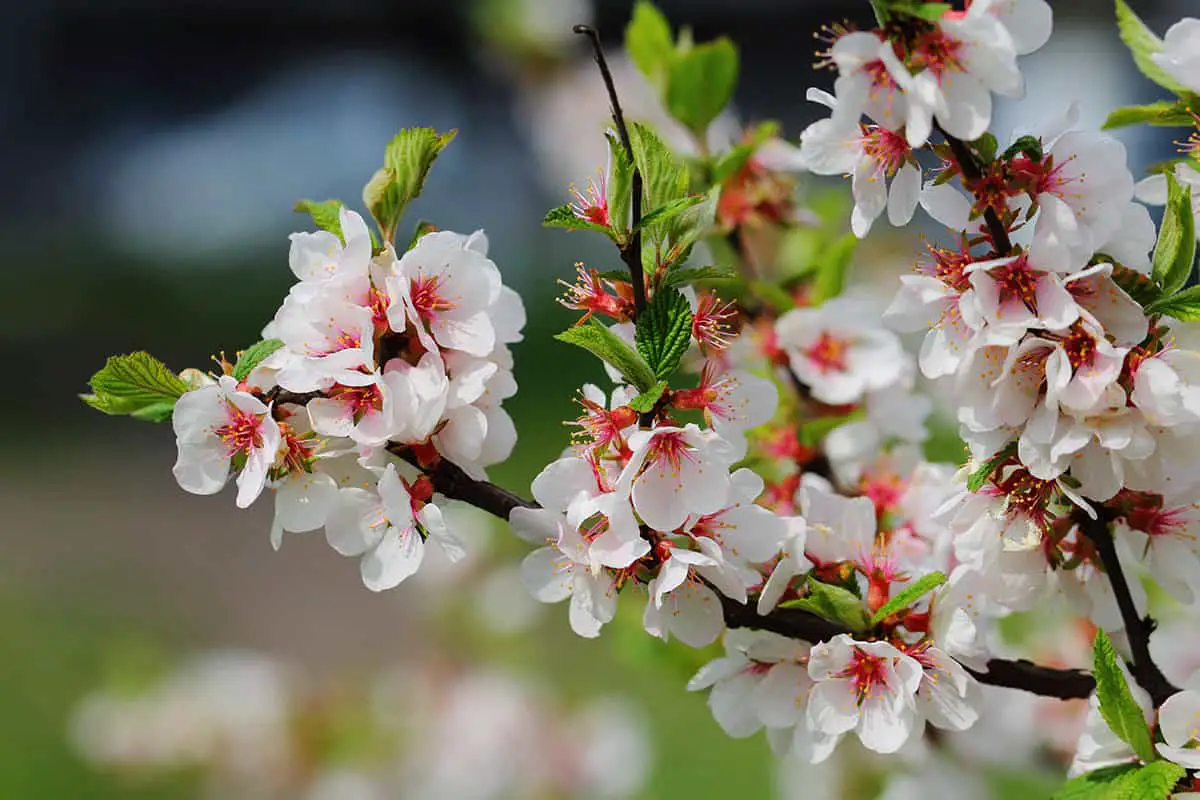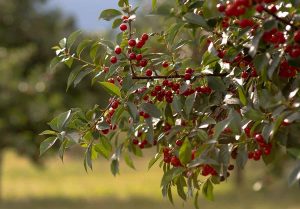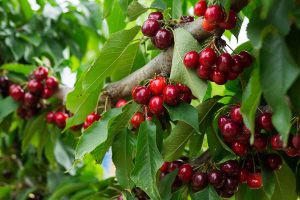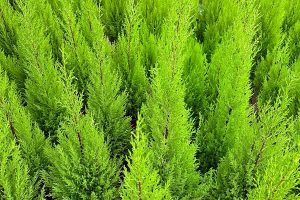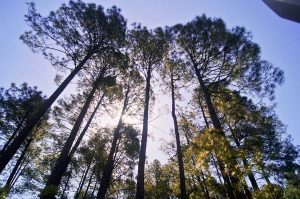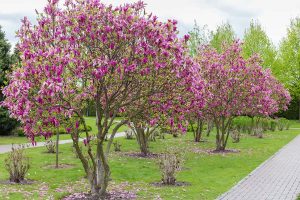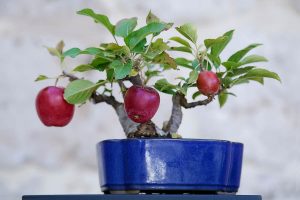Cherry blossom trees are a sight to behold in spring, as they are among the first trees in the landscape to bloom in pretty shades of pink or white.
Cherry blossom trees are popularly cultivated for their floral appeal, but they can also retain interest all year around, thanks to their graceful silhouette and often unusual colored bark. Here we look at the most popular types of cherry blossom for a range of growing conditions.
Table of Contents
Weeping Cherry
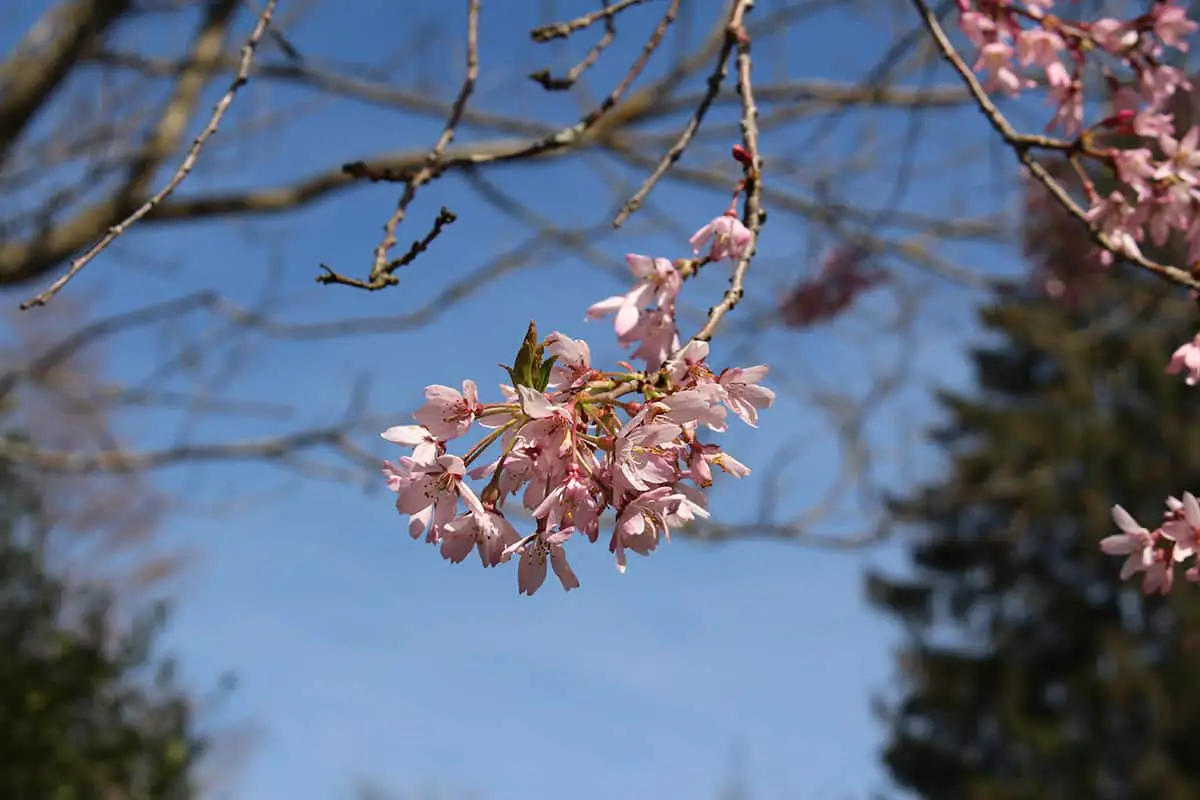
- Botanical name: Prunus pendula
- Common names: Weeping Cherry
- Plant family: Rosaceae
- USDA hardiness zone: 5 – 8
- Mature height: 15 to 25 feet
- Mature spread: 15 to 25 feet
This is a type of Japanese cherry tree that forms a weeping habit as the pendulous branches gently arc over and drape down toward the ground. The tree has a compact growth habit, making for a spectacular specimen in home gardens and parks. Like most cherry blossom trees, the Weeping Cherry is best known for the profusion of flowers it delivers each spring.
These will emerge in dense clusters before the arrival of the foliage, either at the very end of winter or early on in spring, depending on the climate. The flowers start out as deep pink buds, and open out into delightful pastel pink blossoms.
White flowering varieties of Weeping Cherry are also available, such as the Prunus pendula ‘Snow Fountains’. This type of cherry blossom tree is an ideal choice for a long flowering period because it will typically remain in bloom for around a week longer than most other species of Prunus.
The Weeping Cherry tree should be grown in full sun, in a well-draining soil that is kept consistently moist.
Cherry Plum

- Botanical name: Prunus cerasifera
- Common names: Cherry Plum, Black Cherry Plum, Myrobalan Plum
- Plant family: Rosaceae
- USDA hardiness zone: 4 – 9
- Mature height: 20 feet
- Mature spread: 15 to 20 feet
The Cherry Plum tree is a type of cherry blossom which is native to Western Asia and Southern Europe. It has also naturalized in parts of the United Kingdom, some of the United States, and pockets of Australia where it is considered to be invasive. This deciduous tree is among the first of all cherry blossom trees to flower, with buds opening out as early as February.
The flowers bloom in clusters on the bare branches, creating a display of vivid color in a typically dull landscape. There are numerous cultivars of the Cherry Plum, which offer a variety of different characteristics and qualities. The Prunus cerasifera ‘Nigra’ is especially popular due to its pink blossoms set against black foliage, while the Prunus cerasifera ‘Thundercloud’ produces white flowers on deep purple twigs and branches.
Most commonly, though, the flowers of the Cherry Plum tree are pink, and the foliage that follows will be green and ovate, measuring up to 3 inches in length. The blossoms develop into edible red fruits which can be ripe as early as July.
Cherry Plum trees grow in full sun to partial shade, but the best color for both the flowers and the foliage will be achieved in full sun. The soil of this tree should be well draining and kept consistently moist. It prefers fertile soils but can be grown in average soils. The tree is popular as an ornamental specimen, but it can also be trained to grow into a flowering hedge for privacy.
Nanking Cherry
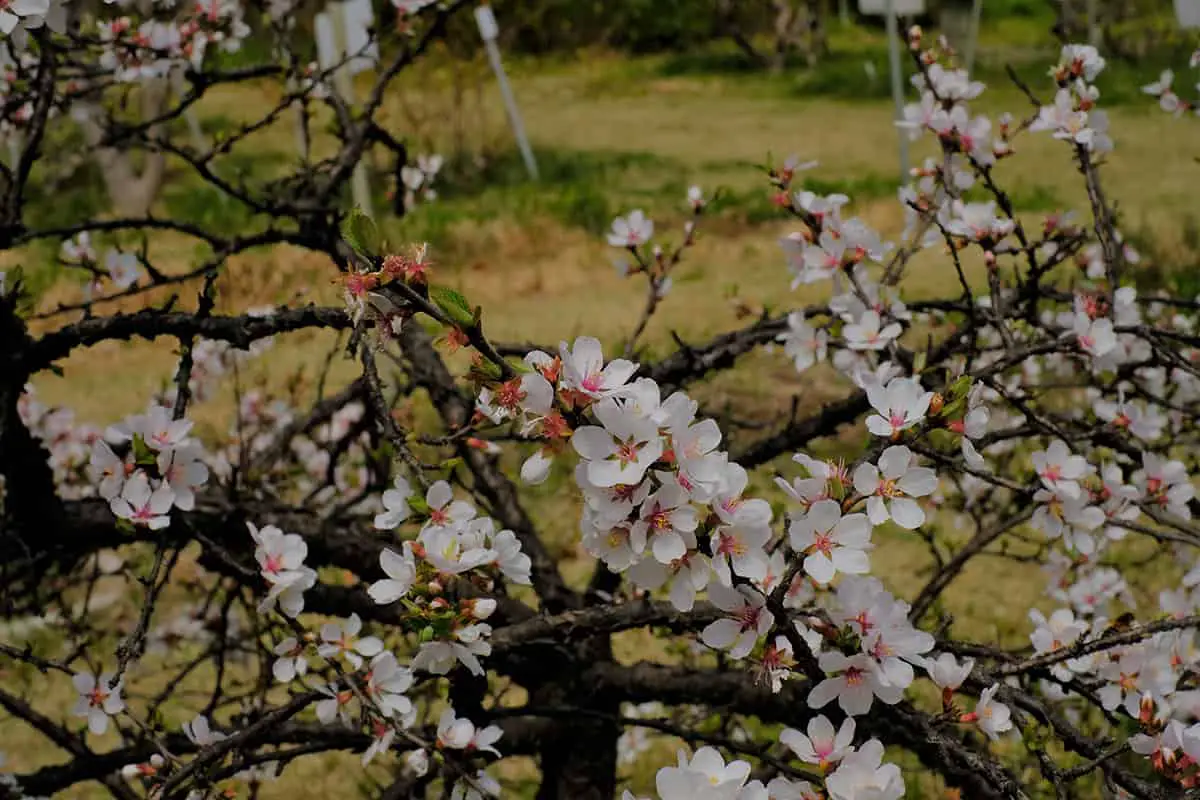
- Botanical name: Prunus tomentosa
- Common names: Nanking Cherry, Ando Cherry, Korean Cherry, Nanjing Cherry, Downy Cherry, Manchu Cherry, Mountain Cherry
- Plant family: Rosaceae
- USDA hardiness zone: 2 – 7
- Mature height: 6 to 10 feet
- Mature spread: 12 to 15 feet
The Nanking Cherry can be grown as a medium shrub or a dwarf tree. It is native to China, India, Korea, and Mongolia, and was introduced to both the United States and the United Kingdom in the late 1800s for its fruiting and flowering qualities. The buds of the tree emerge in spring as pale pink balls, and they open out at around the same time as the leaves unfurl, revealing pure white blossoms that cover the lengths of the branches and twigs.
The flowers can measure up to an inch across, and feature dark pink to red stalks and calyx, for a vibrant contrast. They are sweetly scented, and develop into bright red fruits which are almost identical to regular cherries. Despite their visual similarity, the fruits of the Nanking Cherry are actually more closely related to plums than cherries.
They can be eaten fresh or used in making jams, pies, wines, and fruit juices. The foliage of the tree is covered in fine hairs, which is why one of the names for this tree is ‘Downy Cherry’. It is a widely cultivated species for a number of reasons, including the way it maintains interest through every season. Once the leaves have been shed, the bark of the tree is revealed, which exfoliates in curling ribbons in a dark shade of bronze.
The Nanking Cherry is exceptionally hardy to cold temperatures and can be grown in climates as low as USDA hardiness zone 2. The plant will also fare well in climates with warm summers, and it can survive periods of drought, though it prefers moist and well-draining soil types.
Sargent’s Cherry
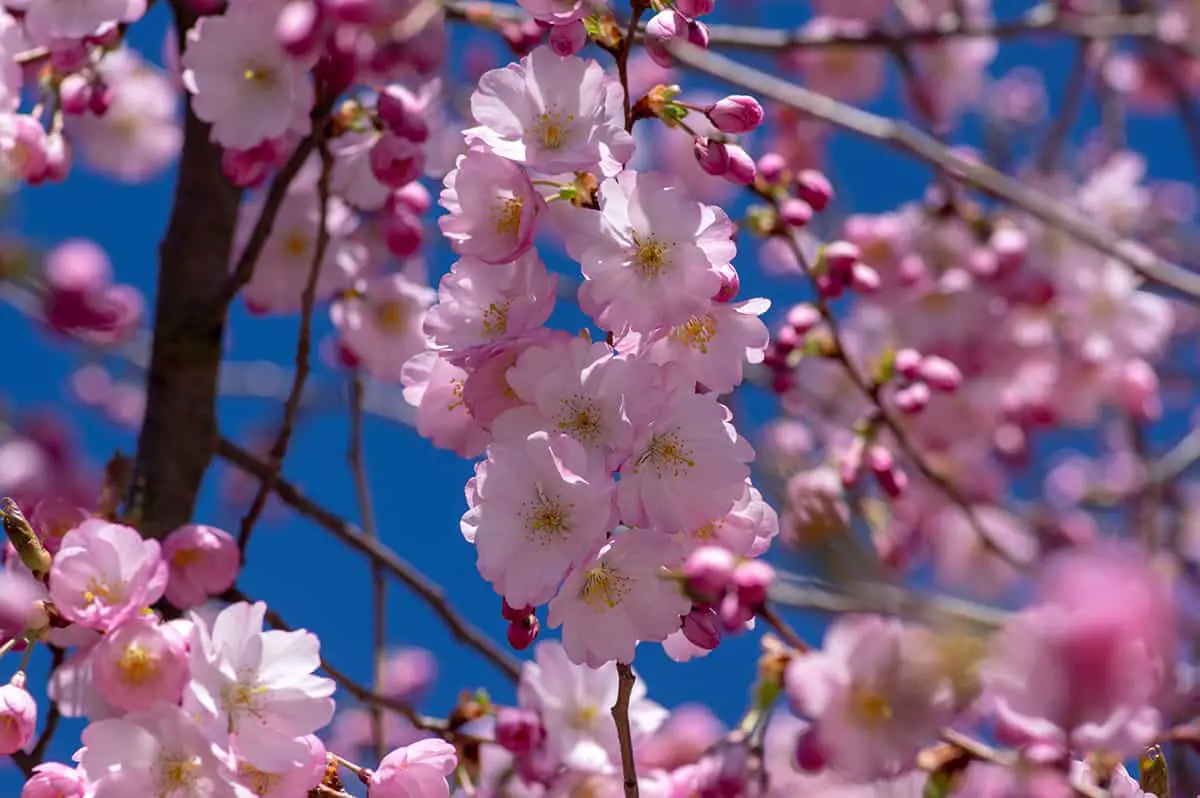
- Botanical name: Prunus sargentii
- Common names: Sargent’s Cherry, North Japanese Hill Cherry
- Plant family: Rosaceae
- USDA hardiness zone: 5 – 9
- Mature height: 20 to 30 feet
- Mature spread: 20 to 30 feet
Sargent’s Cherry is native to Korea and Japan, and it was introduced to North America and the UK as an ornamental specimen in the early 20th century. The tree is small to medium in size, with a spread that will usually be equal to, or exceeding the height of the tree.
It produces pink flowers ranging from blush through to deep magenta, which bloom along the bare branches in dense clusters in spring before the arrival of the leaves. Serrated foliage emerges at the end of spring, which is flushed with red and develops to deep green by midsummer.
The leaves warm up to shades of orange and red before dropping to the ground in fall. The fruits of the Sargent’s Cherry tree ripen at the beginning of summer as dark purple, almost black cherries. These are sour in taste but are notoriously popular with birds and wildlife. Through winter, the tree retains interest with its graceful habit and smooth, red-brown bark.
Sargent’s Cherry should be planted in well-draining soil which is moderately moist, though periods of drought will be tolerated amongst mature trees. It does not do well under extreme heat or high levels of humidity. The best color is achieved when grown in full sun. However, leaf scorch can occur if the soil is not kept moist in direct sun.
Tibetan Cherry
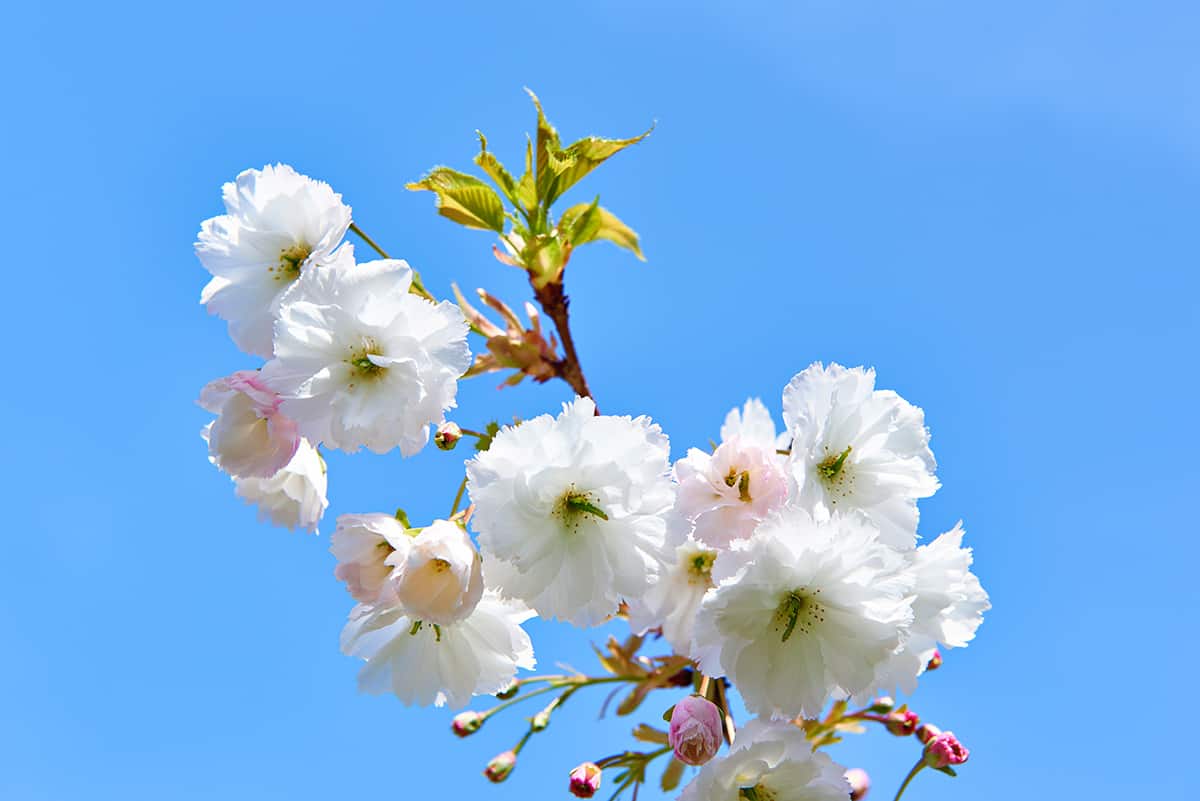
- Botanical name: Prunus serrula
- Common names: Tibetan Cherry, Paperbark Cherry, Birch Bark Cherry, Red Bark Cherry
- Plant family: Rosaceae
- USDA hardiness zone: 6 – 8
- Mature height: 20 to 30 feet
- Mature spread: 20 to 30 feet
The Tibetan Cherry tree is well known for its striking bark, which exfoliates like the bark of a birch tree. The bark is silky smooth in a bright shade of copper, and it has a high gloss effect that shimmers in the sunlight. It peels away in thin, horizontal ribbons to reveal bumpy cream-colored bark beneath.
Despite being grown for its unusual bark, the Tibetan Cherry is actually a stunning cherry blossom tree that puts on a prolific display of spring flowers. The tree blooms in spring, with clusters of white or pink blossoms, which develop into red cherries by the fall. The foliage of the tree is dark green, and it becomes red and bronze before the leaves are shed in the fall.
The Tibetan Cherry is native to China but is popular around the world as an ornamental specimen. It grows easily, though it is fairly slow growing. It is highly adaptable, being well suited to growing in any type of soil, though moist and well-draining soil is preferred. It can be grown in full sun or partial shade, though the full sun will bring out the best color.
Yoshino Cherry
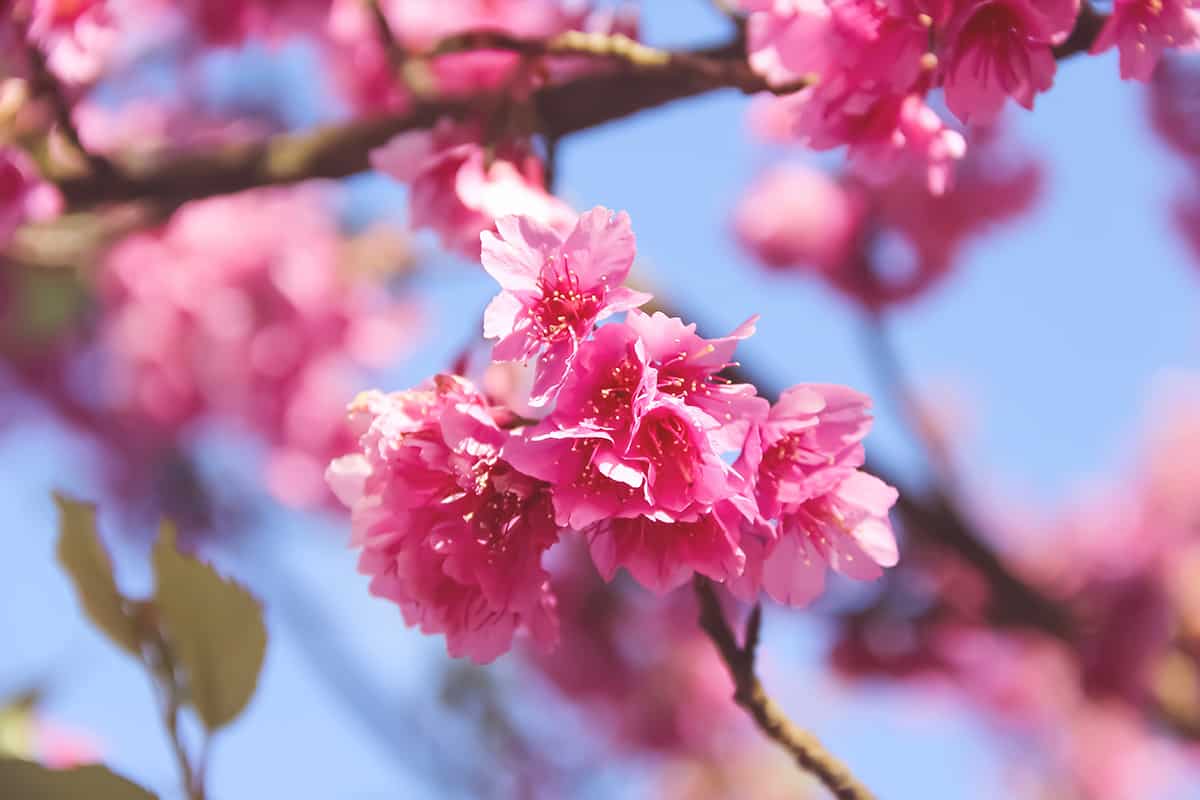
- Botanical name: Prunus x yedoensis
- Common names: Yoshino Cherry
- Plant family: Rosaceae
- USDA hardiness zone: 5 – 8
- Mature height: 40 to 50 feet
- Mature spread: 20 to 30 feet
The Yoshino Cherry tree is a hybrid species that has the Prunus speciosa and the Prunus pendula f. ascendens as its parent plants. It is one of the most popular types of flowering trees which is cultivated around the world, for its incredible display of almond-scented flowers, which completely cover the branches of the tree every spring.
The flowers arrive as pale pink buds in early spring on the bare branches, and they bloom into blush pink blossoms, which mature to a creamy-white color. They remain on the tree, creating a spectacular floral feature, for around three weeks. They then develop into glossy black cherries, which are feasted upon by birds. The foliage of the tree is dark green through summer, and it warms up to autumnal shades before dropping in the fall.
The Yoshino Cherry is, unfortunately, quite short-lived, typically lasting just 15 to 20 years. However, it is very fast growing and can reach heights of up to 50 feet in its short lifespan, making it a great choice in gardens where you want to quickly fill a space with color and structure.
The Yoshino Cherry should be grown in full sun or partial shade. It can tolerate a wide range of conditions, including humidity, heat, and most soil types. It cannot survive drought, and it is also prone to suffering from pests and disease.
American Plum
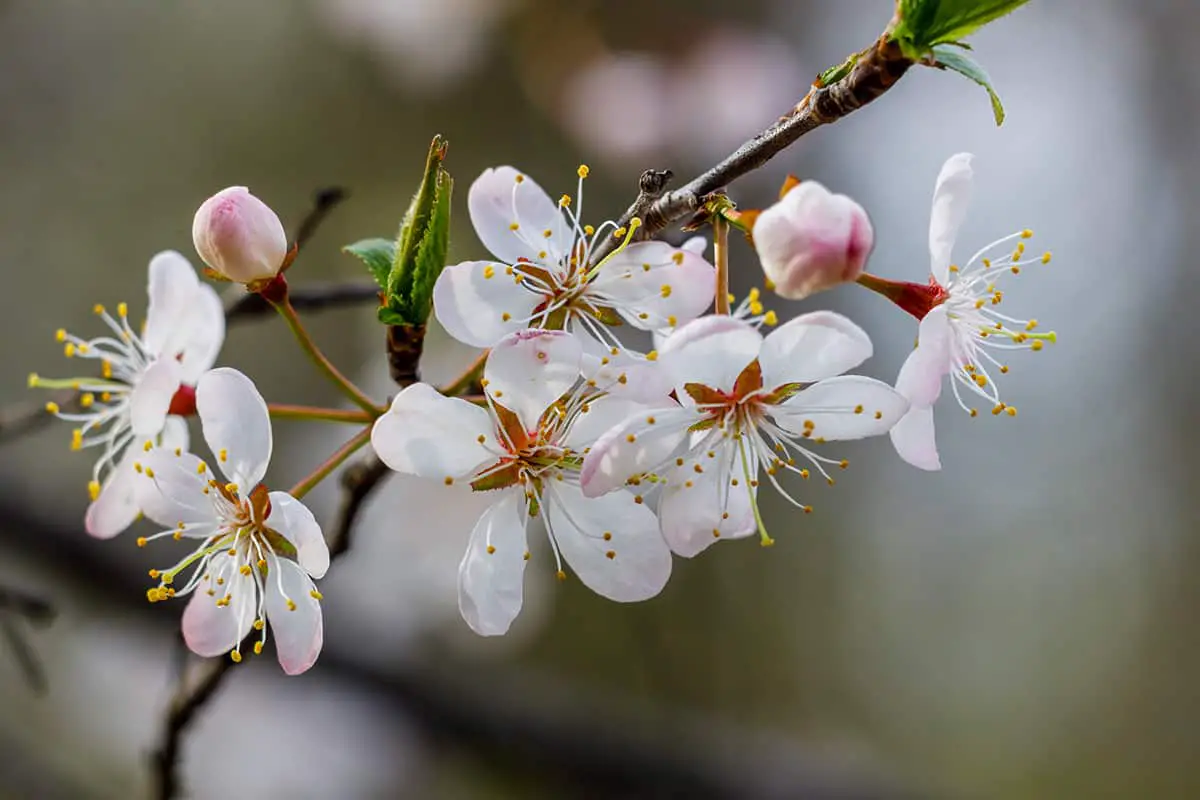
- Botanical name: Prunus americana
- Common names: American Plum, Goose Plum, Canada Plum, Hog Plum, River Plum, Sloe Plum
- Plant family: Rosaceae
- USDA hardiness zone: 3 – 8
- Mature height: 15 to 20 feet
- Mature spread: 15 to 20 feet
The American Plum can be grown as a small tree or multi-stemmed, medium-sized shrub. It is a deciduous plant which is native to much of North America, from Saskatchewan in Canada down to Florida in the United States. The tree is beautiful throughout spring, producing thousands of small white cherry blossoms on the bare branches of the plant.
These are held in small clusters and last for a few weeks before developing into red plums in the early summer months. The fruits are sweet and widely harvested for use in jams, pies, and preserves, unless they are devoured by birds first.
The American Plum can be grown in full sun or partial shade, though the best color is achieved in full sun. The soil around this tree should be well draining and can be kept dry to moist.
Japanese Cherry
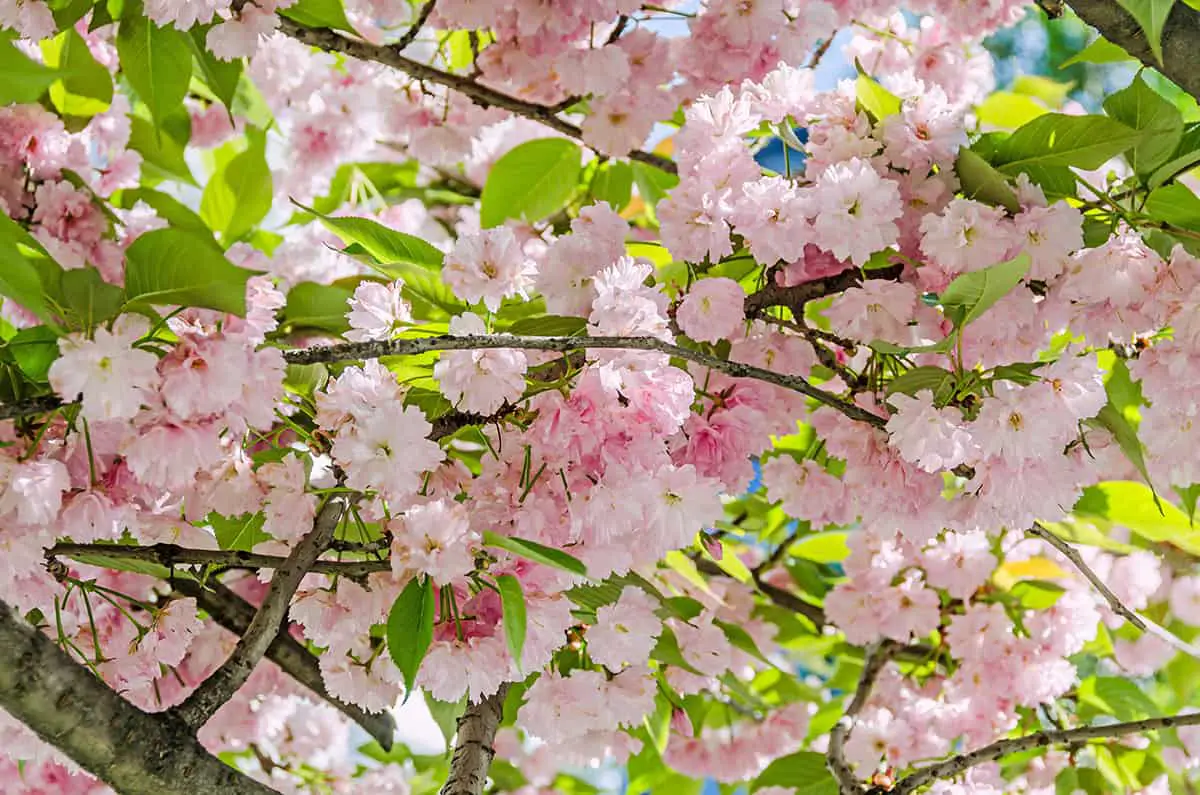
- Botanical name: Prunus serrulata
- Common names: Japanese Cherry, East Asian Cherry, Oriental Cherry
- Plant family: Rosaceae
- USDA hardiness zone: 4 – 9
- Mature height: 20 to 30 feet
- Mature spread: 20 to 30 feet
The Japanese Cherry tree is native to Japan, and it is widely grown as an ornamental tree in temperate regions around the world. It is famed for its clusters of blossoms which appear in spring at the same time as the leaves are unfurling. The flowers can be pink or white depending on the cultivar, and these often will not develop into fruits in the same way that other cherry trees do.
On the Japanese Cherry trees which do produce fruits, they are bitter or sour tasting and are not considered to be a good enough quality to eat. The foliage of the tree is green and serrated, taking on hues of orange, red, and bronze in fall before the leaves are shed.
The Japanese Cherry tree can be grown in full sun or partial shade and will need a minimum of 4 hours of direct sunlight each day in order to bloom. It should be kept in well-draining soils that are consistently moist.
